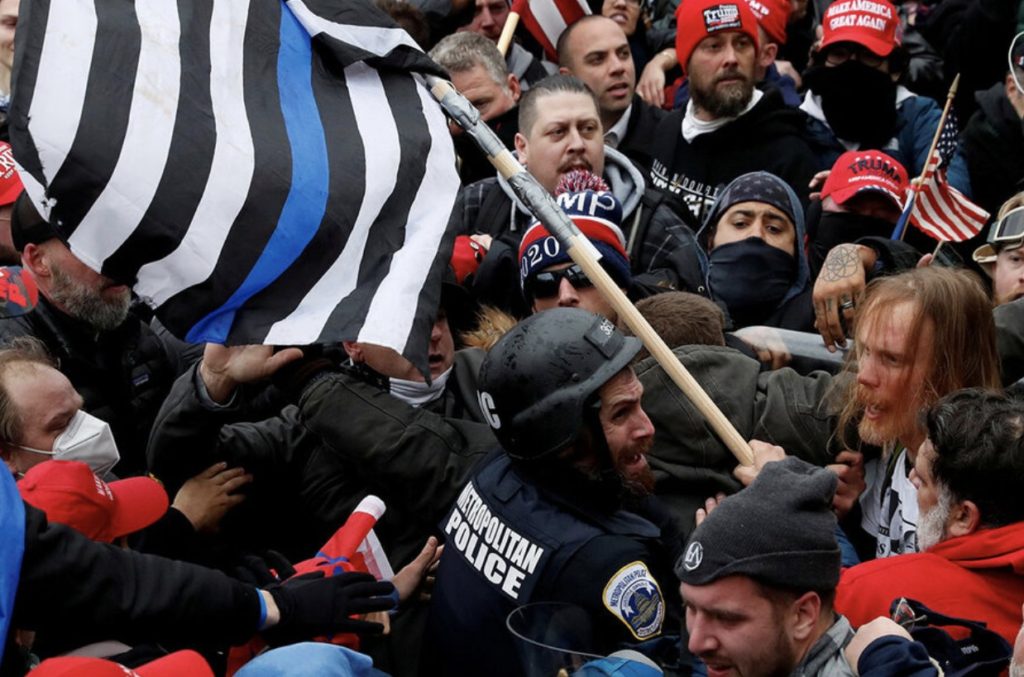
In videos played back during the second impeachment hearings by House Impeachment Managers, rioters on and around Capitol grounds on Jan. 6 repeatedly scream “traitor” at Capitol Police Officers. They accuse on-duty police of breaking their oaths, failing to act like Americans, and being Nazis.
51-year-old Capitol Police Officer Howard Liebengood, who had worked at the Capitol since 2005, took his own life on Jan. 9, days after responding to the storming of the Capitol. On Jan. 15, 35-year-old Officer Jeffrey Smith also died by suicide after working at the building on the day of the attack. According to a statement put out by Capitol Police, Officer Brian Sicknick was fatally injured “while engaging with protesters” during the riot. Sicknick died the next day. At least 15 officers were hospitalized after the riots, and a minimum of 138 officers were bruised, burned, concussed, and one suffered a heart attack, “ranking [the day] among the worst days for law enforcement injuries since the Sept. 11, 2001, terrorist attacks.”
On Feb. 22, a member of one of the largest Facebook pages called “Blue Lives Matter” (with 2.2 million followers) posted a Police Tribune article about the families of police officers who were working at the Capitol and later died by suicide to have their loved ones’ deaths categorized as line-of-duty. The article refers to calls from Liebengood’s and Smith’s widows to have their husbands’ deaths acknowledged as sacrifices made in the fight against insurrection. While some comments under the post express condolences, many dismiss the idea, calling suicide “a choice” and invalid as a death “in the line of duty.”
Even before the impeachment hearings in February, the trauma faced by Capitol Police officers on Jan. 6 was made graphically public. Accounts from journalists, lawmakers, and officers told of police facing down a crowd that far outnumbered them, and experiencing grave injuries, including smashed spinal discs, cracked ribs, destroyed eyes, and stabbings.
The violence done against on-duty police officers at the Capitol who attempted to protect the building (as opposed to some, who allegedly let rioters in), as well as the response to these police deaths and injuries, has exposed the true allegiances of “blue lives matter” supporters. The phrase “blue lives matter” was never sincerely about protecting law enforcement officials or their families – it was most vitally about opposing the movement for justice for Black people. I don’t doubt that, months ago, there was real fervor for the idea of rallying around the police. But the willingness to maim and spurn those who the movement’s supporters claimed to champion, and their apparent apathy towards injured or killed officers, betrayed the “blue lives matter” movement as merely an expression of commitment to a militant, racist, and far-right ideology, not a police force meant to protect the general public. When a time came to choose between the police and loyalty to Donald Trump and the attack he provoked, many of the people who spent months exalting “blue lives” embraced bald alt-right brutality. In the process, the standard-bearers of “blue lives matter” have invalidated their cause. Office Harry Dunn, a Black policeman who was guarding the Capitol on the day of the attack, described rioters as “beat[ing] police officers with Blue Lives Matter flags.”
Since early January, photos and other evidence have revealed that many in the crowd of insurrectionists were police officers themselves. It has also been discovered that some on-duty officers collaborated with rioters by moving barricades aside for them, allowing them to enter the Capitol. According to Rep. Tim Ryan [D-OH], one Capitol Police officer “wore a Trump-supporting hat and was directing protesters around the building.” As of mid-February, six U.S. Capitol Police officers had been suspended without pay in connection with participation in some capacity in the insurrection, and 29 others remain under investigation.
It has been documented that many members of American law enforcement harbor no small sympathies for far-right extremism, and have often acted on them. The New York Times found that over the summer of 2020, armed right-wing groups and individuals had brought weapons to at least 100 Black Lives Matter demonstrations. At some events, such as in Philadelphia and Chicago in June, on-duty officers handed out drinks to armed vigilantes, “posed for pictures with armed civilians” and “wore symbols from armed far-right movements.” A comparison by PolitiFact concluded that Capitol Police failed catastrophically to prepare for an event that was preceded by “many red flags,” as opposed to the zealousness put on display to the injury of those attending racial justice demonstrations.
Given this pattern of behavior, it is understandable that the individuals in videos from Jan. 6 were surprised to encounter police officers who were not wholly on their side. Why should they be shocked when the standard set for police has allowed them to shake hands with armed far-right militias?
United States law enforcement officers who patrol cities, towns and rural areas will never be antiracist protectors of the general public. The people who cry “blue lives matter” know this. On Jan. 6, police officers were victimized by their supposed defenders. These vigilantes proved that their devotion was never to police, who are now at best abetting, and at worst crusading, in the war to advance the true vision of “blue lives matter”: a country dominated by far-right extremism.
